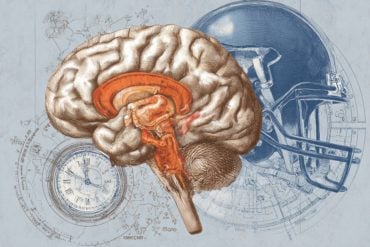Summary: A new study reveals the oxygenation levels in the placenta during the last trimester of pregnancy are a key predictor of the development of the cerebral cortex and likely childhood cognition and behavior.
Utilizing magnetic resonance imaging (MRI) for a more accurate assessment of placental health, the study offers new insights into how the placenta mediates the impact of maternal health on fetal brain development.
This research not only underscores the placenta’s critical role in early neurodevelopment but also opens the door to potential early interventions and treatments for neurodevelopmental disorders.
Key Facts:
- MRI Over Ultrasound: MRI provides a more specific and precise imaging of placental growth and its impact on fetal brain development compared to traditional ultrasound.
- Impact on Cortical Growth: Healthy placental oxygenation levels in the third trimester are crucial for the development of the cerebral cortex, which plays a significant role in learning and memory.
- Potential for Early Intervention: The findings highlight the importance of monitoring placental health for early detection of potential cognitive and behavioral issues in children, pointing towards new directions for prenatal care and interventions.
Source: University of Western Ontario
A new study shows oxygenation levels in the placenta, formed during the last three months of fetal development, are an important predictor of cortical growth (development of the outermost layer of the brain or cerebral cortex) and is likely a predictor of childhood cognition and behaviour.
“Many factors can disrupt healthy brain development in utero, and this study demonstrates the placenta is a crucial mediator between maternal health and fetal brain health,” said Emma Duerden, Canada Research Chair in Neuroscience & Learning Disorders at Western University, Lawson Health Research Institute scientist and senior author of the study.

The connection between placental health and childhood cognition was demonstrated in previous research using ultrasound, but for this study, Duerden, research scientist Emily Nichols and an interdisciplinary team of Western and Lawson researchers used magnetic resonance imaging (MRI), a far superior and more holistic imaging technique.
This novel approach to imaging placental growth allows researchers to study neurodevelopmental disorders very early on in life, which could lead to the development of therapies and treatments.
“While ultrasound provides some measure of placental function, it is imprecise and prone to error, so MRI is just a bit more specific and precise,” said Nichols, lead author of the study.
“You wouldn’t use MRI necessarily to diagnose placental growth restriction, you would use ultrasound, but MRI gives us a much better way to understand the mechanisms of the placenta and how placental function is affecting the fetal brain.”
The study, published today in the high impact journal JAMA Network Open, was led by Duerden and Nichols and co-authored by researchers from the Faculty of Education, Schulich School of Medicine & Dentistry, Western Engineering and Lawson Health Research Institute.
The placenta, an organ that develops in the uterus during pregnancy, is the main conduit for oxygenation and nutrients to a fetus, and a vital endocrine organ during pregnancy.
“Anything a fetus needs to grow and thrive is mostly delivered through the placenta so if there is anything wrong with the placenta, the fetus might not be receiving the nutrients or the levels of oxygenation it needs to thrive,” said Nichols.
Poor nutrition, smoking, cocaine use, chronic hypertension, anemia, and diabetes may result in fetal growth restriction and may cause problems for the development of the placenta. Fetal growth restriction is relatively common and happens in about six per cent of all pregnancies and globally impacts 30 million pregnancies each year.
“There can be many issues related to the healthy development of the placenta,” said Duerden. “If it does not develop properly, the fetal brain may not get enough oxygen and nutrients, which may affect childhood cognition and behaviour.”
Impact, affect and change
The study revealed that a healthy placenta in the third trimester particularly impacts the cortex and the prefrontal cortex, regions of the child’s brain that are important for learning and memory.
“An unhealthy placenta can place babies at risk for later life learning difficulties, or even something more serious, like a neurodevelopmental disorder,” said Duerden.
“This research can open a lot of doors as we still don’t really understand everything there is to know about the placenta. We are just scratching the surface.”
The study, funded by grants from Brain Canada, The Children’s Health Research Institute, Canadian Institutes of Health Research, BrainsCAN and the Molly Towell Perinatal Research Foundation, is also an important first step in biomarking the impact of oxygenation levels in the placenta and considering changes for expectant mothers to deal with less-than-ideal placental conditions.
While oxygenation in the placenta in the third trimester predicts fetal cortical growth (development of the outermost layer of the brain – the cerebral cortex), results of the study indicate it may not affect subcortical maturation, or the deep gray and white matter structures of the brain.
Subcortical structures in the brain, responsible for children’s temperament or motor functions such as the amygdala and basal ganglia, may be more vulnerable to factors affecting the placenta in the second trimester.
“We now have a better understanding of how the placenta affects the cortex. With this basic knowledge, we now have an idea of how these two things are related and we can identify or benchmark healthy levels that lead to brain cortical growth,” said Nichols.
“The subcortical regions of the brain appear to be unaffected by placental growth, at least in the healthy samples from our study.”
Duerden, Nichols, and the team scanned pregnant women twice (during their third trimester) for the study at Western’s Translational Imaging Research Facility.
“This is one of the few datasets in the world where there are two scans collected in utero during the third trimester. There are not many groups in the world doing fetal MRI, so it is a super-rich data set that allows us to look at growth over time,” said Duerden.
“Western is probably one of the few places where we can do the research because we have the expertise and the facilities to do it.”
About this neurodevelopment research news
Author: Jeffrey Renaud
Source: University of Western Ontario
Contact: Jeffrey Renaud – University of Western Ontario
Image: The image is credited to Neuroscience News
Original Research: Open access.
“T2* Mapping of Placental Oxygenation to Estimate Fetal Cortical and Subcortical Maturation” by Emma Duerden et al. JAMA Network Open
Abstract
T2* Mapping of Placental Oxygenation to Estimate Fetal Cortical and Subcortical Maturation
Placental dysfunction is associated with a decrease in nutrients and oxygen to the fetus; the gestational age at which this happens varies depending on severity but is an important factor in outcome as it relates to when and which brain structures are most at risk.
Evidence from Doppler ultrasonography of fetuses affected by severe placental dysfunction leading to intrauterine growth restriction (IUGR) suggests blood flow distribution occurs in a hierarchical manner. In IUGR, oxygenated blood is directed toward the brain, away from other fetal organs (except the fetal heart), a process referred to as brain sparing.
Further evidence suggests that subcortical regions critical for homeostasis receive more blood flow, at the cost of cortical regions involved in higher-order functions.
Although Doppler findings suggest that cortical regions show more variability to placental oxygenation changes, a Cochrane review found that the evidence was of moderate to low quality, indicating the need for more sensitive techniques to study how placental function affects the brain.
Recent work has demonstrated an association between a magnetic resonance imaging (MRI)–based measure of placental oxygenation, transverse relaxation time (T2*), and birth weight,2 suggesting that T2* may similarly estimate variations in fetal brain development.
To determine whether placental MRI-based methods could provide a biomarker of fetal brain development, we investigated the association between placental T2* and cortical and subcortical fetal brain volumes in typically developing fetuses scanned longitudinally in the third trimester. We hypothesized that in fetuses with reduced placental oxygenation, cortical brain regions would show reduced volumes relative to subcortical regions.






